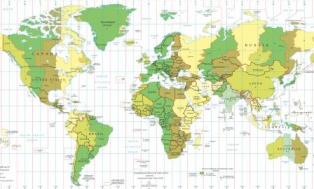
Time Zones Map
A time zone is a region of the earth that has uniform standard time, usually referred to as the local time. Time zones compute their local time as an offset from UTC (also refered as Greenwich Mean Time). Local time is UTC plus the current time zone offset for the considered location.
Time zones are divided into standard and daylight saving (or summer). Daylight saving time zones (or summer time zones) include an offset (typically +1) for daylight saving time.
Standard time zones (Winter Time zones) can be defined by geometrically subdividing the Earth's spheroid into 24 lunes (wedge-shaped sections), bordered by meridians each 15° of longitude apart. The local time in neighboring zones would differ by one hour. However, political boundaries, geographical practicalities, and convenience of inhabitants can result in irregularly-shaped zones. Moreover, in a few regions, half-hour or quarter-hour differences are in effect.
Before the adoption of time zones, people used local solar time. Originally this was apparent or true solar time, as shown by a sundial, and later it became mean solar time, as kept by most mechanical clocks. Mean solar time has days of equal length, but the difference between mean and apparent solar time, called the equation of time, averages to zero over a year.
The use of local solar time became increasingly awkward as railways and telecommunications improved, because clocks differed between places by an amount corresponding to the difference in their geographical longitude, which was usually not a convenient number. This problem could be solved by synchronizing the clocks in all localities, although in many places the local time would then differ markedly from the solar time to which people were accustomed. Time zones are thus a compromise, relaxing the complex geographic dependence while still allowing local time to approximate the mean solar time. There has been a general trend to push the boundaries of time zones further west of their designated meridians in order to create a permanent daylight saving time effect. The increase in worldwide communication has further increased the need for interacting parties to communicate mutually comprehensible time references to one another.
Check out this Free Time Zones Converter to convert time zone between regions.
